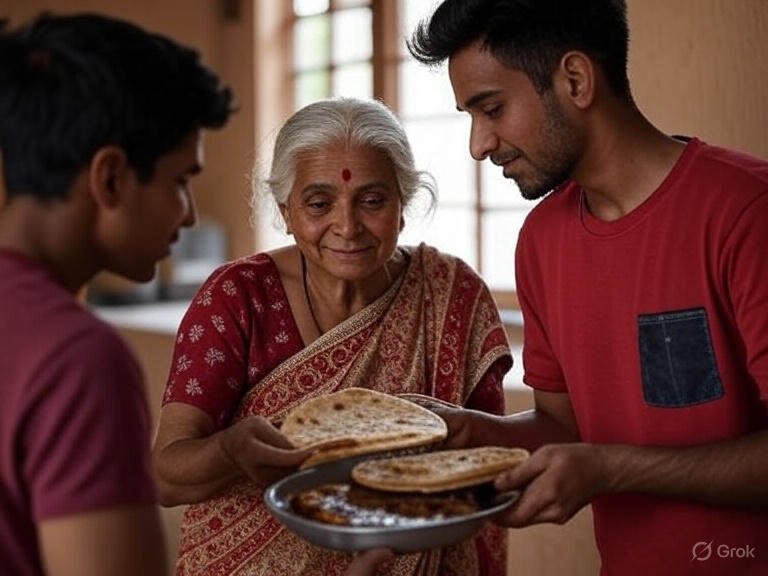A guide on how to politely, but firmly, decline food (saying no) from a relative without triggering a multi-generational guilt trip in Indian households.
If you have grown up in India—or even visited an Indian home during mealtime—you already know the most difficult three-letter word in our culture: “No.” Not for an exam, not for marriage proposals, not even for rejecting another WhatsApp family group. The real Everest is saying “no” to an affectionate auntie hovering near your plate with yet another buttery, golden-brown aloo paratha in hand.
She insists. You resist. She persists. And before you know it, one aloo paratha has turned into three, topped with an extra dollop of ghee you didn’t ask for. You push back politely, only to be countered with a guilt trip that spans both the maternal and paternal bloodlines. Suddenly, refusing a paratha feels like rejecting family, culture, and perhaps even the Indian Constitution itself.
This is where our guide comes in: how to say “no” without sparking the legendary drama of Indian kitchens, and how to walk away with your dignity—and your digestion—intact.
Ready? Let’s roll the dough.
Why Food Equals Love in Indian Homes
In the Indian context, food isn’t just about nutrients. It is hospitality, honor, tradition, and emotion rolled into one stuffed paratha. The act of feeding someone has roots in Sanskrit philosophy itself—Atithi Devo Bhava (the guest is like God). Serving food, especially in abundance, is a deeply ingrained marker of care.
For aunties, neighbors, or cousins twice removed, serving you parathas is more than just feeding—it’s:
- A metric of affection: The more she serves you, the more loved you feel (or at least, the more loved she thinks you should feel).
- Proof of hospitality: A plate that isn’t overflowing is often seen as stinginess.
- Preservation of culture: Recipes are heirlooms; tastes are memory banks. Auntie’s paratha is an edible family tree.
- Societal duty: In many families, especially in North India, a well-fed guest means a respected household.
So, when you dare to say “No, I don’t want one more paratha,” Auntie doesn’t hear a dietary decision. She hears:
- “Your love means nothing.”
- “This family ritual is pointless.”
- “Your cooking, which you have perfected over decades, is unappreciated.”
Now you understand why she sighs dramatically, complains under her breath, or recounts how your grandfather once ate nine parathas in a row and still had space for halwa.
The Great Indian Guilt Trip: A Breakdown
Every seasoned eater in an Indian home knows the phases of negotiation that follow the initial “No.” They are as predictable as a Bollywood plot twist.

- The Shock: “Arrey, bas ek aur. You are saying no?!”
2. The Logic Trap: “It’s small only, just half. Potatoes are good for energy. You look so weak.”
3. The Emotional Punch: “So you don’t like my cooking? Everyone else takes three.”
4. The Ancestor Argument: “Your dadaji ate five and then went to the farm in the summer sun!”
5. The Silent Protest: She sulks in the corner, muttering, “No one in this house eats what I make anymore…”
Declining feels less like refusing extra calories and more like breaking an intergenerational treaty.
Why You Must Learn to Say “No”
Before we learn survival tactics, let’s clarify: it’s not about disrespecting auntie. It’s about self-preservation, both physical and mental.
- Health comes first: Too many parathas = that mid-day food coma and long-term cholesterol spikes.
- Boundaries matter: Saying no to family food pressures teaches you to assert yourself gently but firmly in bigger life situations.
- Preventing waste: Many second servings end up uneaten, adding to the food wastage problem.
- Redefining love: It’s important to remind both yourself and your family that love can be expressed without overstuffing plates.
Battle-Tested Tactics to Decline Auntie’s Paratha
Here are time-honored strategies, perfectly suitable for the Indian family dining table.
The Doctor’s Note Technique
Medical authority instantly trumps auntie authority. Politely say:
“Doctor has advised me not to eat too much heavy food in one sitting.”
She may grumble about modern doctors, but she won’t risk fighting divine medical decrees.
Compliment and Redirect
Instead of directly saying no, cushion it with flattery:
“Auntie, this paratha is unmatched. If I eat more, I won’t be able to enjoy the memory of it properly. Please pack one for me instead.”
The Amma-At-Home Excuse
“I want to eat more, but mummy will be upset if I skip her dinner after coming here. You know how mothers are!”
This works because one mother’s authority can only be countered by another mother’s authority.
The Visual Trick: Half-Plate Diplomacy
Allow her to put another paratha, then break it in half and leave the visibly untouched part on the plate. Auntie feels successful, you feel free.
The Diversion Maneuver
Quickly distract—”Auntie, where did you buy this achar from? It’s fantastic!” Engage her in a 10-minute pickle history discussion. By the time she remembers, your stomach fortress is safe.
Recruit the Hungry Cousin
Find the cousin or nephew who loves parathas. Redirect: “Auntie, give my share to him. He has been eyeing it since morning!” Not only do you escape, you become the hero for said cousin.

Flowchart: How to Politely Refuse an Auntie’s Extra Aloo Paratha (Indian Household Edition)
Master Scripts for Polite Refusals
Here are some ready-to-deploy, India-specific phrases you can use:
- “Bas, bas, Auntie. I want to keep space for tea and samosa later.”
- “Itna tasty hai ki main already overeat kar raha hoon! Abhi roko mujhe!”
- “Auntie, your parathas are so filling that ek hi kaafi hai for the whole day!”
- “Aap toh roz mujhe khila nahi paate, iss ek bite ko yaadgar banne dijiye.”
- “Please save one for tomorrow. I want to stretch the joy.”
Notice the structure: appreciation + reason + gentle humor. This formula works like magic.
When You Should Actually Say Yes
There are contexts in India where refusing food outright will look extremely rude. Examples:
- Festivals (Diwali, Holi, Eid, Onam, Pongal) – food is sacred during celebrations. Skip the fourth paratha, but don’t skip the first or second.
- First Visits to a New Relative’s House – first impressions overrule digestion.
- Weddings and Big Poojas – saying no might look like rejecting blessings, not food.
In these cases, consider compromising. Take the extra paratha but nibble on it slowly, or wrap half discreetly in a tissue to eat later.
Rewiring the Family Dynamic
A larger cultural lesson here: by learning to say no without guilt, you also help rewire familial norms. A kid watching you politely decline sees that love is not measured in plates finished. A cousin may later feel empowered to also say, “No more, thank you.”
This is generational healing—gradually shifting the script away from overeating as obligation, toward mindful eating as respect.
The Philosophy Behind Refusing a Paratha
At a deeper level, the paratha represents more than food. It is the symbol of life’s endless “just one more” offers. One more job, one more WhatsApp group, one more errand, one more responsibility.
By learning to politely decline the paratha, you are practicing the art of boundary-setting everywhere else. Like a yoga for your willpower, each “No” to the paratha strengthens your “No” to unnecessary pressures beyond the dining table.
An Illustrated Scenario
Picture this:
- You: Already had two parathas, holding your stomach.
- Auntie: Marches back with one more, dripping in butter.
- You (smiling): “Auntie, I would never forgive myself if I couldn’t enjoy your achar properly because of overeating. Let me stop here so I can keep savoring your flavors.”
- Auntie (momentarily confused, then beaming): “Wah, acha bola beta. Thik hai. I’ll pack some for you.”
Congratulations. You have won the game of paratha politics without dishonoring the lineage.
A Last Bite of Wisdom
Saying “no” to an auntie’s extra aloo paratha is one of the toughest acts of politeness in Indian family life. It requires diplomacy sharper than foreign policy negotiations, humor filthier than Bollywood innuendos, and firmness stronger than the rolling pin used to flatten the dough.
But it is also an act of self-love. You are teaching your body that its fullness is sacred. You are reminding your auntie that affection goes beyond caloric intake. And you are showing future generations that respect can co-exist with boundaries.
So the next time, raise your palm with a smile, hold back the paratha, and let your stomach breathe. Because the art of saying “no,” like the art of making a perfectly round paratha, is a skill every Indian must master.





Really enjoyed reading this! You made the tricky topic of saying “no” feel light, practical, and relatable. Loved the way you blended humor with real-life situations — it definitely made me smile and think at the same time. I wish I had known these techniques couple of decades ago, my belly would have been few inches less 🤔
Thanks for sharing!
Hey Vijay,
Thank you for your kind words.
It’s never too late for anything and, look at me, I still don’t have a belly, although I need one 🙂
It is a real pleasure share such sacred secrets.
Thanks again.
Anil